Analysis of Qantas's 2015 Sustainability Report - ACCT2127, Sem 1
VerifiedAdded on 2023/06/13
|18
|6453
|92
Report
AI Summary
This report provides a comprehensive analysis of Qantas Airways' 2015 sustainability report, evaluating the company's financial, social, and environmental performance. The financial analysis highlights Qantas's strong performance, achieving its best results since the Global Financial Crisis, with significant profit before tax and a healthy operating cash flow. The report examines the company's environmental initiatives, focusing on carbon emission reduction and energy efficiency, alongside its social performance, including wealth creation and human capital development. The analysis concludes that Qantas's corporate social responsibility efforts in 2015 were highly effective, contributing to long-term success and providing valuable insights for investors. The report also incorporates financial data, including total assets, liabilities, and cash flows, to support its assessment of Qantas's sustainability and overall business strategy.
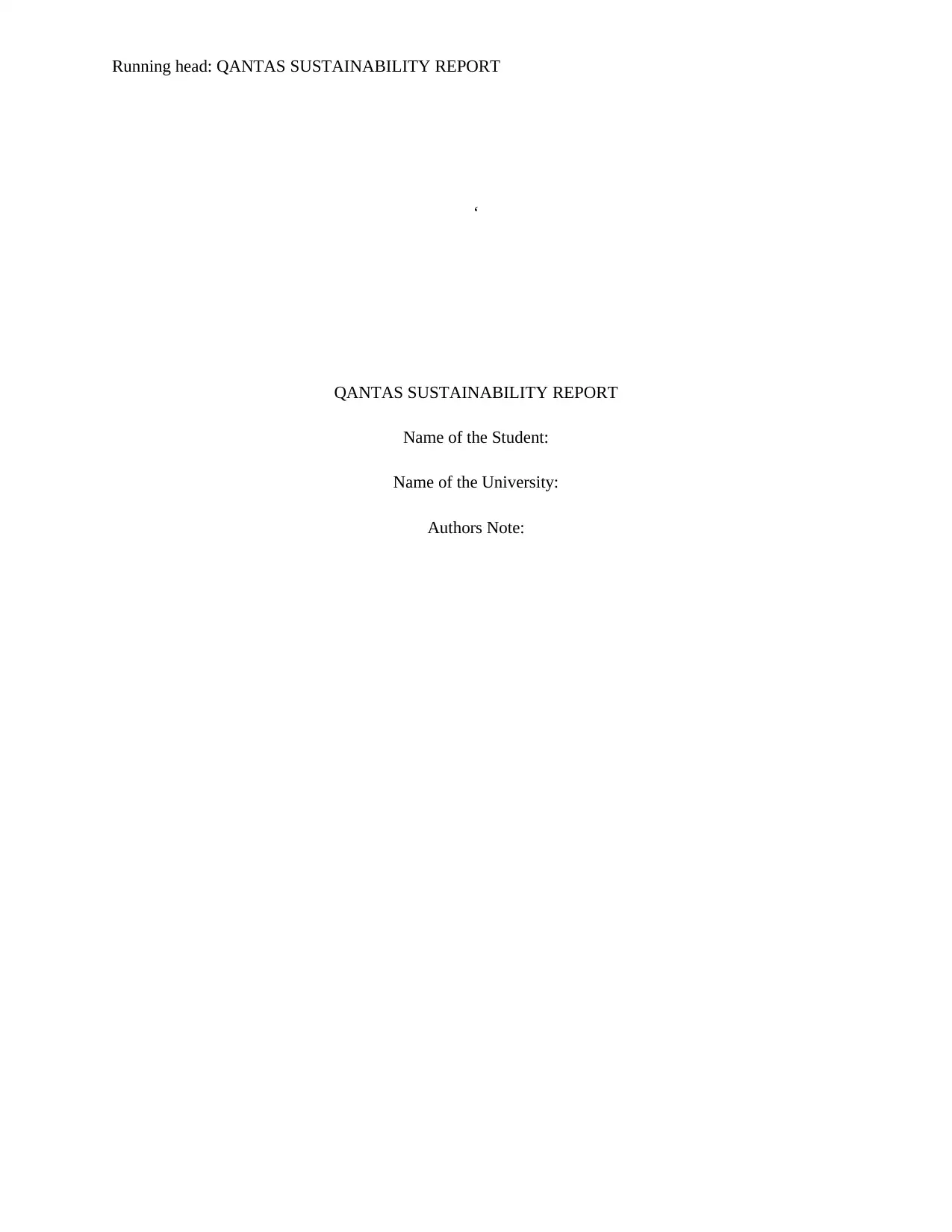
Running head: QANTAS SUSTAINABILITY REPORT
‘
QANTAS SUSTAINABILITY REPORT
Name of the Student:
Name of the University:
Authors Note:
‘
QANTAS SUSTAINABILITY REPORT
Name of the Student:
Name of the University:
Authors Note:
Paraphrase This Document
Need a fresh take? Get an instant paraphrase of this document with our AI Paraphraser
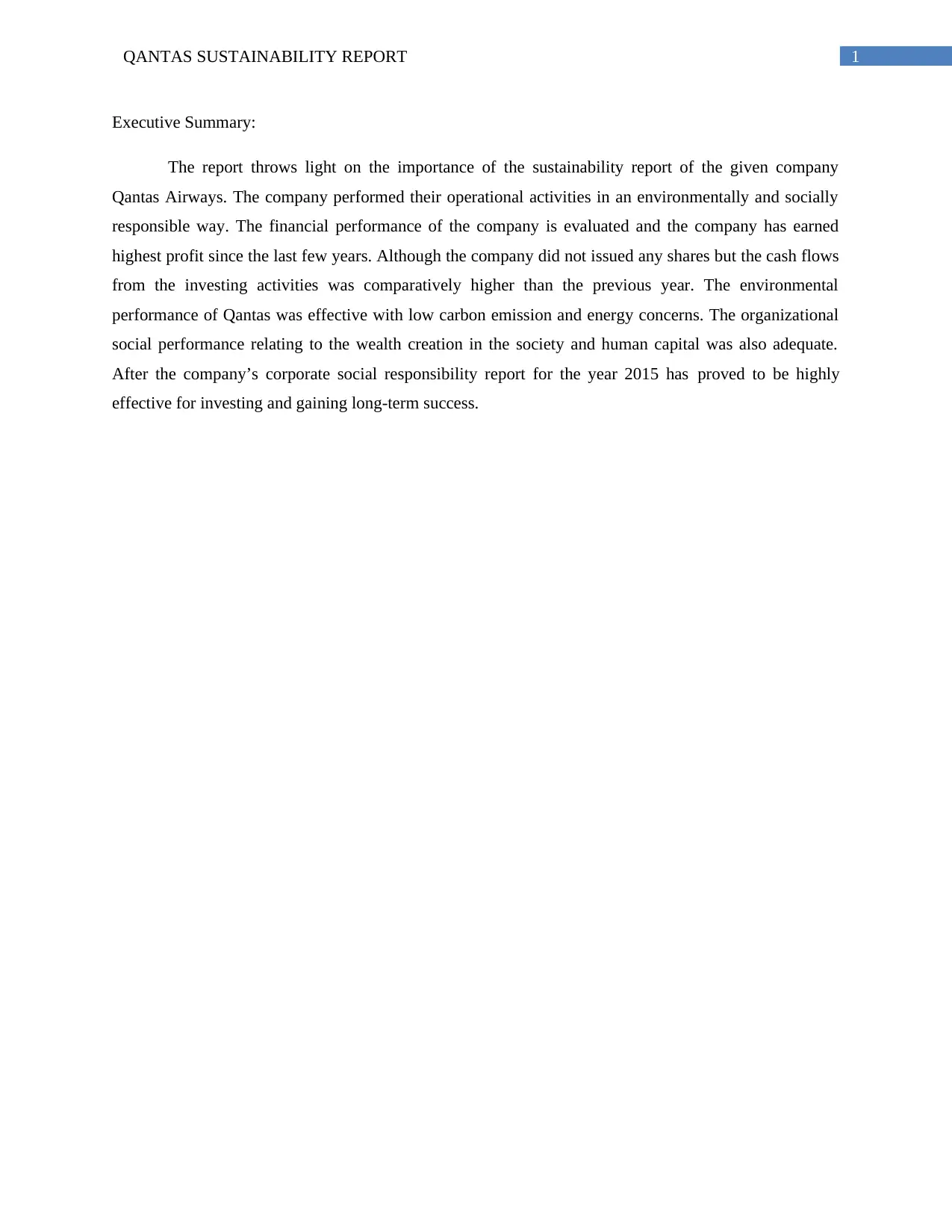
1QANTAS SUSTAINABILITY REPORT
Executive Summary:
The report throws light on the importance of the sustainability report of the given company
Qantas Airways. The company performed their operational activities in an environmentally and socially
responsible way. The financial performance of the company is evaluated and the company has earned
highest profit since the last few years. Although the company did not issued any shares but the cash flows
from the investing activities was comparatively higher than the previous year. The environmental
performance of Qantas was effective with low carbon emission and energy concerns. The organizational
social performance relating to the wealth creation in the society and human capital was also adequate.
After the company’s corporate social responsibility report for the year 2015 has proved to be highly
effective for investing and gaining long-term success.
Executive Summary:
The report throws light on the importance of the sustainability report of the given company
Qantas Airways. The company performed their operational activities in an environmentally and socially
responsible way. The financial performance of the company is evaluated and the company has earned
highest profit since the last few years. Although the company did not issued any shares but the cash flows
from the investing activities was comparatively higher than the previous year. The environmental
performance of Qantas was effective with low carbon emission and energy concerns. The organizational
social performance relating to the wealth creation in the society and human capital was also adequate.
After the company’s corporate social responsibility report for the year 2015 has proved to be highly
effective for investing and gaining long-term success.
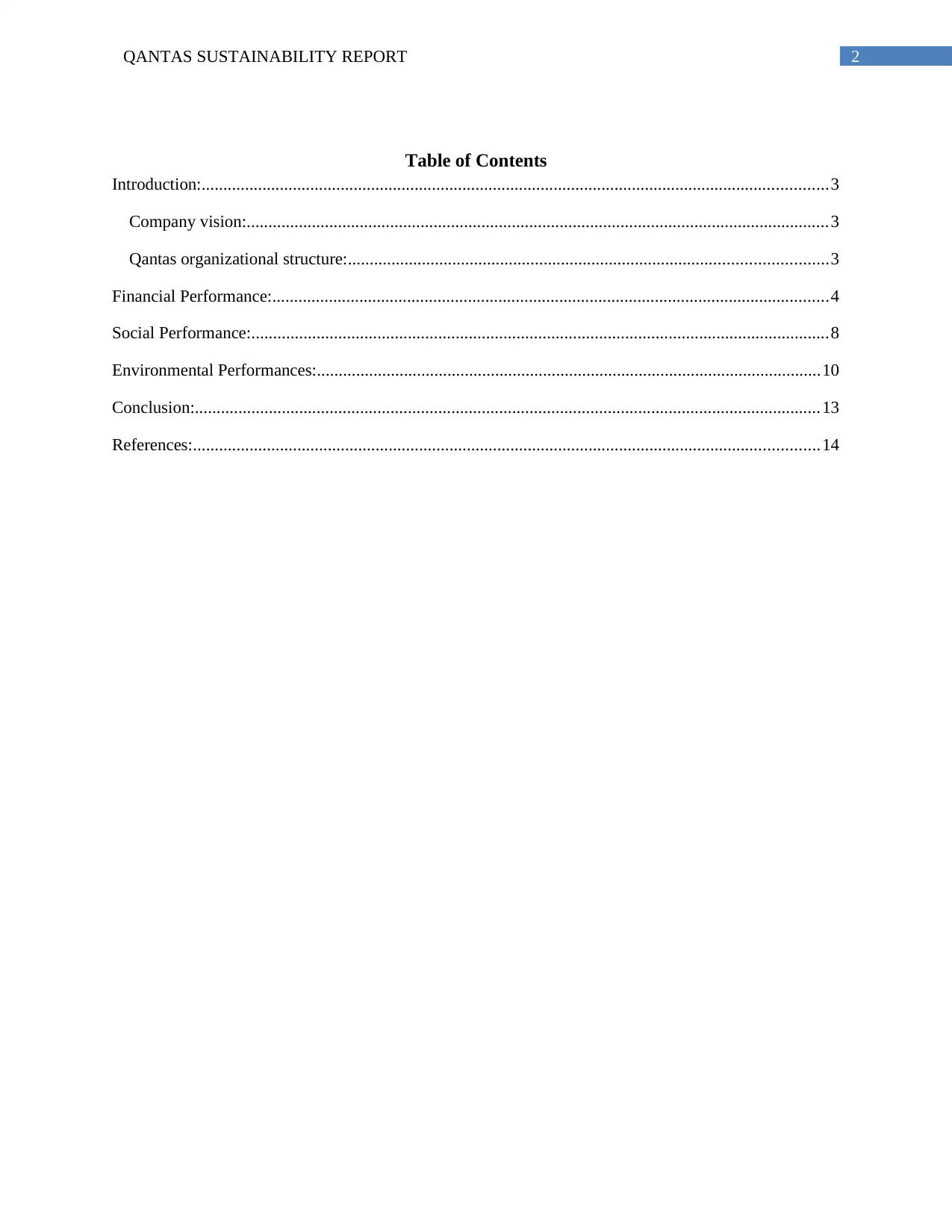
2QANTAS SUSTAINABILITY REPORT
Table of Contents
Introduction:................................................................................................................................................3
Company vision:......................................................................................................................................3
Qantas organizational structure:..............................................................................................................3
Financial Performance:................................................................................................................................4
Social Performance:.....................................................................................................................................8
Environmental Performances:....................................................................................................................10
Conclusion:................................................................................................................................................13
References:................................................................................................................................................14
Table of Contents
Introduction:................................................................................................................................................3
Company vision:......................................................................................................................................3
Qantas organizational structure:..............................................................................................................3
Financial Performance:................................................................................................................................4
Social Performance:.....................................................................................................................................8
Environmental Performances:....................................................................................................................10
Conclusion:................................................................................................................................................13
References:................................................................................................................................................14
⊘ This is a preview!⊘
Do you want full access?
Subscribe today to unlock all pages.

Trusted by 1+ million students worldwide
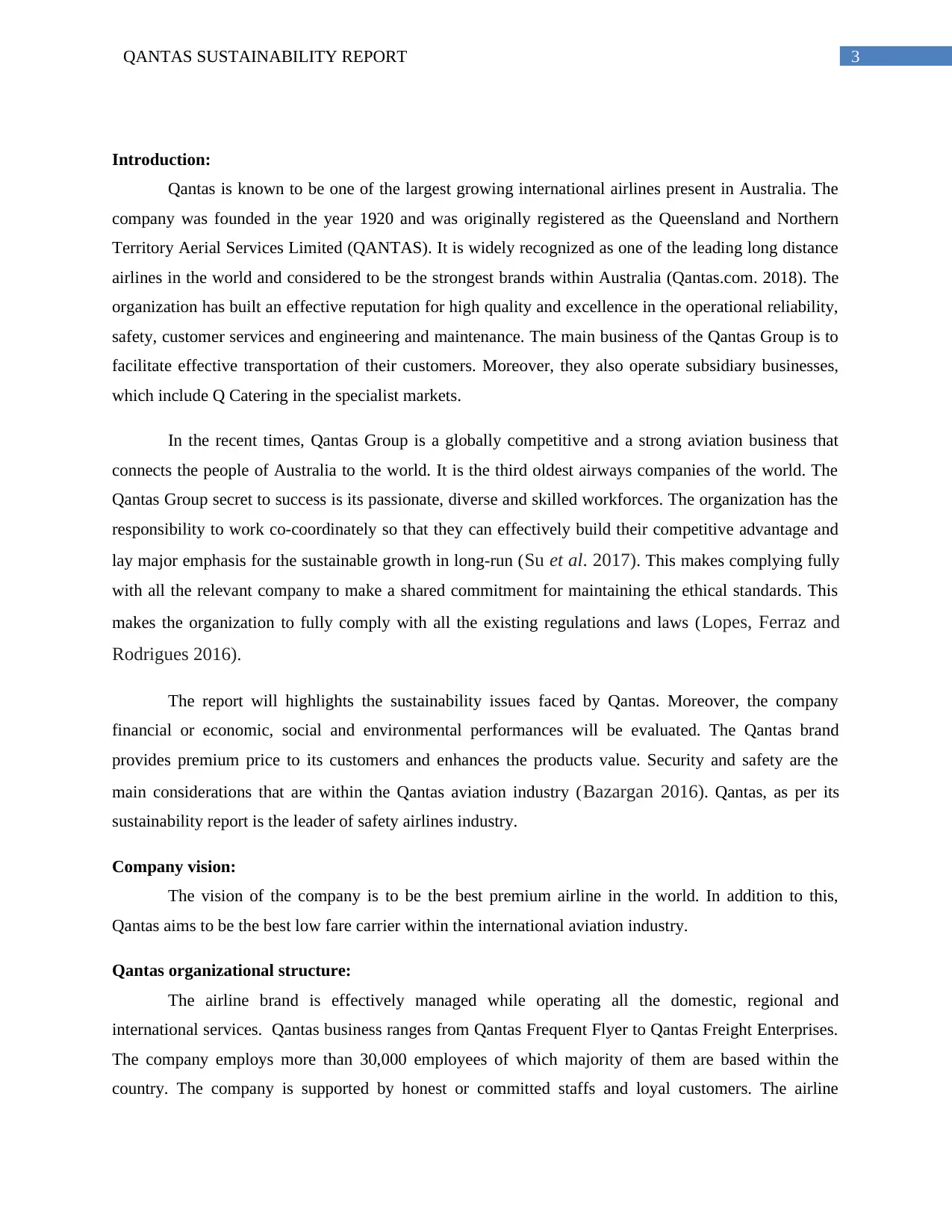
3QANTAS SUSTAINABILITY REPORT
Introduction:
Qantas is known to be one of the largest growing international airlines present in Australia. The
company was founded in the year 1920 and was originally registered as the Queensland and Northern
Territory Aerial Services Limited (QANTAS). It is widely recognized as one of the leading long distance
airlines in the world and considered to be the strongest brands within Australia (Qantas.com. 2018). The
organization has built an effective reputation for high quality and excellence in the operational reliability,
safety, customer services and engineering and maintenance. The main business of the Qantas Group is to
facilitate effective transportation of their customers. Moreover, they also operate subsidiary businesses,
which include Q Catering in the specialist markets.
In the recent times, Qantas Group is a globally competitive and a strong aviation business that
connects the people of Australia to the world. It is the third oldest airways companies of the world. The
Qantas Group secret to success is its passionate, diverse and skilled workforces. The organization has the
responsibility to work co-coordinately so that they can effectively build their competitive advantage and
lay major emphasis for the sustainable growth in long-run (Su et al. 2017). This makes complying fully
with all the relevant company to make a shared commitment for maintaining the ethical standards. This
makes the organization to fully comply with all the existing regulations and laws (Lopes, Ferraz and
Rodrigues 2016).
The report will highlights the sustainability issues faced by Qantas. Moreover, the company
financial or economic, social and environmental performances will be evaluated. The Qantas brand
provides premium price to its customers and enhances the products value. Security and safety are the
main considerations that are within the Qantas aviation industry (Bazargan 2016). Qantas, as per its
sustainability report is the leader of safety airlines industry.
Company vision:
The vision of the company is to be the best premium airline in the world. In addition to this,
Qantas aims to be the best low fare carrier within the international aviation industry.
Qantas organizational structure:
The airline brand is effectively managed while operating all the domestic, regional and
international services. Qantas business ranges from Qantas Frequent Flyer to Qantas Freight Enterprises.
The company employs more than 30,000 employees of which majority of them are based within the
country. The company is supported by honest or committed staffs and loyal customers. The airline
Introduction:
Qantas is known to be one of the largest growing international airlines present in Australia. The
company was founded in the year 1920 and was originally registered as the Queensland and Northern
Territory Aerial Services Limited (QANTAS). It is widely recognized as one of the leading long distance
airlines in the world and considered to be the strongest brands within Australia (Qantas.com. 2018). The
organization has built an effective reputation for high quality and excellence in the operational reliability,
safety, customer services and engineering and maintenance. The main business of the Qantas Group is to
facilitate effective transportation of their customers. Moreover, they also operate subsidiary businesses,
which include Q Catering in the specialist markets.
In the recent times, Qantas Group is a globally competitive and a strong aviation business that
connects the people of Australia to the world. It is the third oldest airways companies of the world. The
Qantas Group secret to success is its passionate, diverse and skilled workforces. The organization has the
responsibility to work co-coordinately so that they can effectively build their competitive advantage and
lay major emphasis for the sustainable growth in long-run (Su et al. 2017). This makes complying fully
with all the relevant company to make a shared commitment for maintaining the ethical standards. This
makes the organization to fully comply with all the existing regulations and laws (Lopes, Ferraz and
Rodrigues 2016).
The report will highlights the sustainability issues faced by Qantas. Moreover, the company
financial or economic, social and environmental performances will be evaluated. The Qantas brand
provides premium price to its customers and enhances the products value. Security and safety are the
main considerations that are within the Qantas aviation industry (Bazargan 2016). Qantas, as per its
sustainability report is the leader of safety airlines industry.
Company vision:
The vision of the company is to be the best premium airline in the world. In addition to this,
Qantas aims to be the best low fare carrier within the international aviation industry.
Qantas organizational structure:
The airline brand is effectively managed while operating all the domestic, regional and
international services. Qantas business ranges from Qantas Frequent Flyer to Qantas Freight Enterprises.
The company employs more than 30,000 employees of which majority of them are based within the
country. The company is supported by honest or committed staffs and loyal customers. The airline
Paraphrase This Document
Need a fresh take? Get an instant paraphrase of this document with our AI Paraphraser
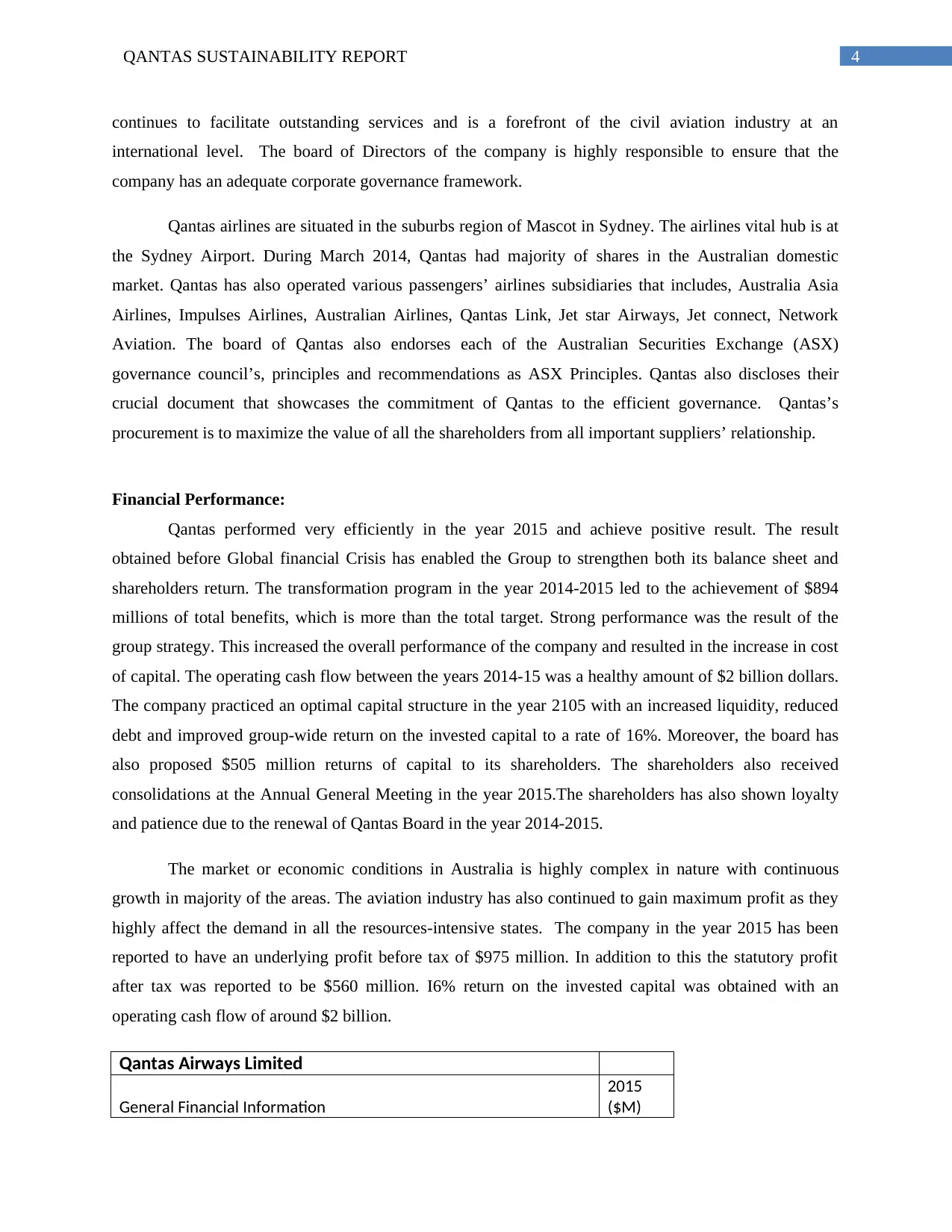
4QANTAS SUSTAINABILITY REPORT
continues to facilitate outstanding services and is a forefront of the civil aviation industry at an
international level. The board of Directors of the company is highly responsible to ensure that the
company has an adequate corporate governance framework.
Qantas airlines are situated in the suburbs region of Mascot in Sydney. The airlines vital hub is at
the Sydney Airport. During March 2014, Qantas had majority of shares in the Australian domestic
market. Qantas has also operated various passengers’ airlines subsidiaries that includes, Australia Asia
Airlines, Impulses Airlines, Australian Airlines, Qantas Link, Jet star Airways, Jet connect, Network
Aviation. The board of Qantas also endorses each of the Australian Securities Exchange (ASX)
governance council’s, principles and recommendations as ASX Principles. Qantas also discloses their
crucial document that showcases the commitment of Qantas to the efficient governance. Qantas’s
procurement is to maximize the value of all the shareholders from all important suppliers’ relationship.
Financial Performance:
Qantas performed very efficiently in the year 2015 and achieve positive result. The result
obtained before Global financial Crisis has enabled the Group to strengthen both its balance sheet and
shareholders return. The transformation program in the year 2014-2015 led to the achievement of $894
millions of total benefits, which is more than the total target. Strong performance was the result of the
group strategy. This increased the overall performance of the company and resulted in the increase in cost
of capital. The operating cash flow between the years 2014-15 was a healthy amount of $2 billion dollars.
The company practiced an optimal capital structure in the year 2105 with an increased liquidity, reduced
debt and improved group-wide return on the invested capital to a rate of 16%. Moreover, the board has
also proposed $505 million returns of capital to its shareholders. The shareholders also received
consolidations at the Annual General Meeting in the year 2015.The shareholders has also shown loyalty
and patience due to the renewal of Qantas Board in the year 2014-2015.
The market or economic conditions in Australia is highly complex in nature with continuous
growth in majority of the areas. The aviation industry has also continued to gain maximum profit as they
highly affect the demand in all the resources-intensive states. The company in the year 2015 has been
reported to have an underlying profit before tax of $975 million. In addition to this the statutory profit
after tax was reported to be $560 million. I6% return on the invested capital was obtained with an
operating cash flow of around $2 billion.
Qantas Airways Limited
General Financial Information
2015
($M)
continues to facilitate outstanding services and is a forefront of the civil aviation industry at an
international level. The board of Directors of the company is highly responsible to ensure that the
company has an adequate corporate governance framework.
Qantas airlines are situated in the suburbs region of Mascot in Sydney. The airlines vital hub is at
the Sydney Airport. During March 2014, Qantas had majority of shares in the Australian domestic
market. Qantas has also operated various passengers’ airlines subsidiaries that includes, Australia Asia
Airlines, Impulses Airlines, Australian Airlines, Qantas Link, Jet star Airways, Jet connect, Network
Aviation. The board of Qantas also endorses each of the Australian Securities Exchange (ASX)
governance council’s, principles and recommendations as ASX Principles. Qantas also discloses their
crucial document that showcases the commitment of Qantas to the efficient governance. Qantas’s
procurement is to maximize the value of all the shareholders from all important suppliers’ relationship.
Financial Performance:
Qantas performed very efficiently in the year 2015 and achieve positive result. The result
obtained before Global financial Crisis has enabled the Group to strengthen both its balance sheet and
shareholders return. The transformation program in the year 2014-2015 led to the achievement of $894
millions of total benefits, which is more than the total target. Strong performance was the result of the
group strategy. This increased the overall performance of the company and resulted in the increase in cost
of capital. The operating cash flow between the years 2014-15 was a healthy amount of $2 billion dollars.
The company practiced an optimal capital structure in the year 2105 with an increased liquidity, reduced
debt and improved group-wide return on the invested capital to a rate of 16%. Moreover, the board has
also proposed $505 million returns of capital to its shareholders. The shareholders also received
consolidations at the Annual General Meeting in the year 2015.The shareholders has also shown loyalty
and patience due to the renewal of Qantas Board in the year 2014-2015.
The market or economic conditions in Australia is highly complex in nature with continuous
growth in majority of the areas. The aviation industry has also continued to gain maximum profit as they
highly affect the demand in all the resources-intensive states. The company in the year 2015 has been
reported to have an underlying profit before tax of $975 million. In addition to this the statutory profit
after tax was reported to be $560 million. I6% return on the invested capital was obtained with an
operating cash flow of around $2 billion.
Qantas Airways Limited
General Financial Information
2015
($M)
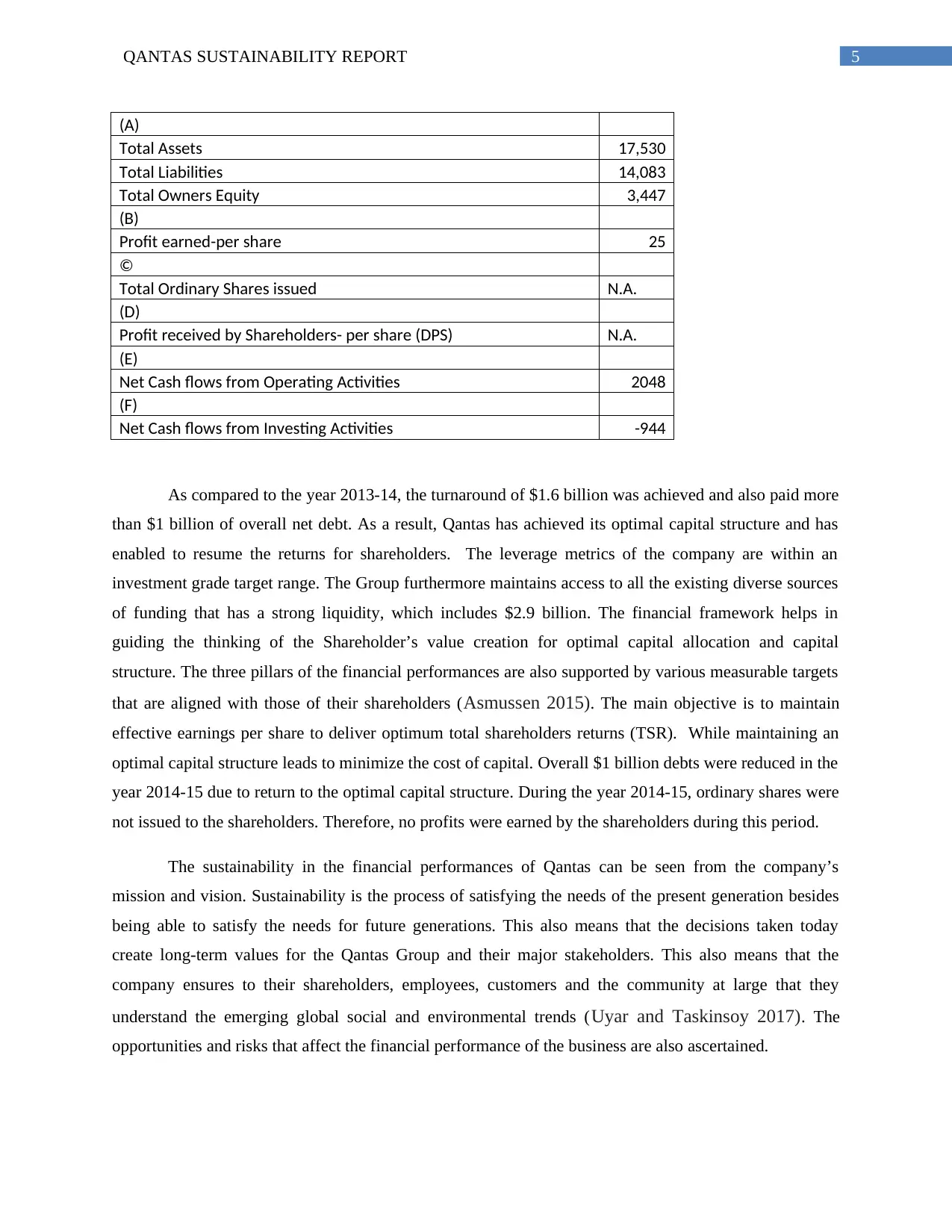
5QANTAS SUSTAINABILITY REPORT
(A)
Total Assets 17,530
Total Liabilities 14,083
Total Owners Equity 3,447
(B)
Profit earned-per share 25
©
Total Ordinary Shares issued N.A.
(D)
Profit received by Shareholders- per share (DPS) N.A.
(E)
Net Cash flows from Operating Activities 2048
(F)
Net Cash flows from Investing Activities -944
As compared to the year 2013-14, the turnaround of $1.6 billion was achieved and also paid more
than $1 billion of overall net debt. As a result, Qantas has achieved its optimal capital structure and has
enabled to resume the returns for shareholders. The leverage metrics of the company are within an
investment grade target range. The Group furthermore maintains access to all the existing diverse sources
of funding that has a strong liquidity, which includes $2.9 billion. The financial framework helps in
guiding the thinking of the Shareholder’s value creation for optimal capital allocation and capital
structure. The three pillars of the financial performances are also supported by various measurable targets
that are aligned with those of their shareholders (Asmussen 2015). The main objective is to maintain
effective earnings per share to deliver optimum total shareholders returns (TSR). While maintaining an
optimal capital structure leads to minimize the cost of capital. Overall $1 billion debts were reduced in the
year 2014-15 due to return to the optimal capital structure. During the year 2014-15, ordinary shares were
not issued to the shareholders. Therefore, no profits were earned by the shareholders during this period.
The sustainability in the financial performances of Qantas can be seen from the company’s
mission and vision. Sustainability is the process of satisfying the needs of the present generation besides
being able to satisfy the needs for future generations. This also means that the decisions taken today
create long-term values for the Qantas Group and their major stakeholders. This also means that the
company ensures to their shareholders, employees, customers and the community at large that they
understand the emerging global social and environmental trends (Uyar and Taskinsoy 2017). The
opportunities and risks that affect the financial performance of the business are also ascertained.
(A)
Total Assets 17,530
Total Liabilities 14,083
Total Owners Equity 3,447
(B)
Profit earned-per share 25
©
Total Ordinary Shares issued N.A.
(D)
Profit received by Shareholders- per share (DPS) N.A.
(E)
Net Cash flows from Operating Activities 2048
(F)
Net Cash flows from Investing Activities -944
As compared to the year 2013-14, the turnaround of $1.6 billion was achieved and also paid more
than $1 billion of overall net debt. As a result, Qantas has achieved its optimal capital structure and has
enabled to resume the returns for shareholders. The leverage metrics of the company are within an
investment grade target range. The Group furthermore maintains access to all the existing diverse sources
of funding that has a strong liquidity, which includes $2.9 billion. The financial framework helps in
guiding the thinking of the Shareholder’s value creation for optimal capital allocation and capital
structure. The three pillars of the financial performances are also supported by various measurable targets
that are aligned with those of their shareholders (Asmussen 2015). The main objective is to maintain
effective earnings per share to deliver optimum total shareholders returns (TSR). While maintaining an
optimal capital structure leads to minimize the cost of capital. Overall $1 billion debts were reduced in the
year 2014-15 due to return to the optimal capital structure. During the year 2014-15, ordinary shares were
not issued to the shareholders. Therefore, no profits were earned by the shareholders during this period.
The sustainability in the financial performances of Qantas can be seen from the company’s
mission and vision. Sustainability is the process of satisfying the needs of the present generation besides
being able to satisfy the needs for future generations. This also means that the decisions taken today
create long-term values for the Qantas Group and their major stakeholders. This also means that the
company ensures to their shareholders, employees, customers and the community at large that they
understand the emerging global social and environmental trends (Uyar and Taskinsoy 2017). The
opportunities and risks that affect the financial performance of the business are also ascertained.
⊘ This is a preview!⊘
Do you want full access?
Subscribe today to unlock all pages.

Trusted by 1+ million students worldwide
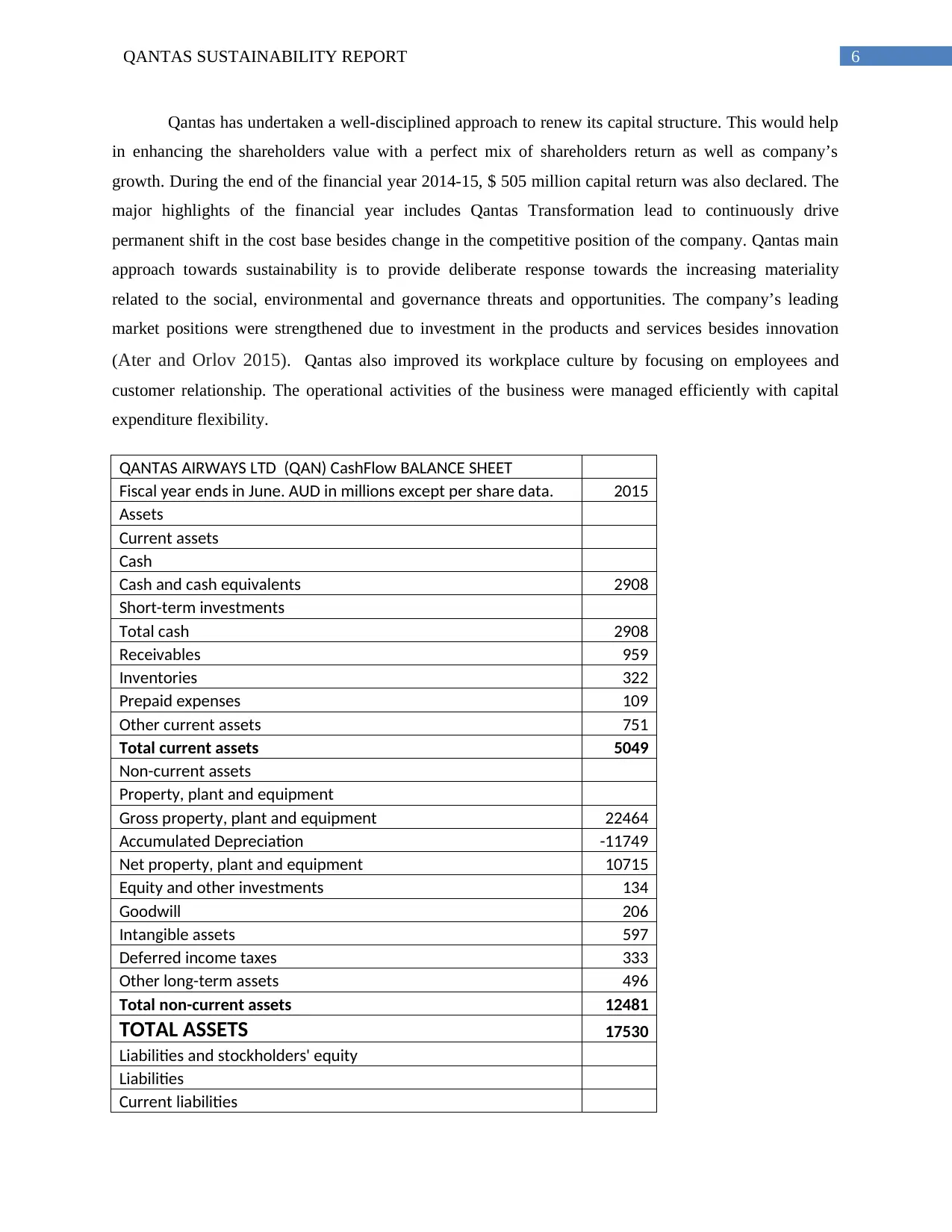
6QANTAS SUSTAINABILITY REPORT
Qantas has undertaken a well-disciplined approach to renew its capital structure. This would help
in enhancing the shareholders value with a perfect mix of shareholders return as well as company’s
growth. During the end of the financial year 2014-15, $ 505 million capital return was also declared. The
major highlights of the financial year includes Qantas Transformation lead to continuously drive
permanent shift in the cost base besides change in the competitive position of the company. Qantas main
approach towards sustainability is to provide deliberate response towards the increasing materiality
related to the social, environmental and governance threats and opportunities. The company’s leading
market positions were strengthened due to investment in the products and services besides innovation
(Ater and Orlov 2015). Qantas also improved its workplace culture by focusing on employees and
customer relationship. The operational activities of the business were managed efficiently with capital
expenditure flexibility.
QANTAS AIRWAYS LTD (QAN) CashFlow BALANCE SHEET
Fiscal year ends in June. AUD in millions except per share data. 2015
Assets
Current assets
Cash
Cash and cash equivalents 2908
Short-term investments
Total cash 2908
Receivables 959
Inventories 322
Prepaid expenses 109
Other current assets 751
Total current assets 5049
Non-current assets
Property, plant and equipment
Gross property, plant and equipment 22464
Accumulated Depreciation -11749
Net property, plant and equipment 10715
Equity and other investments 134
Goodwill 206
Intangible assets 597
Deferred income taxes 333
Other long-term assets 496
Total non-current assets 12481
TOTAL ASSETS 17530
Liabilities and stockholders' equity
Liabilities
Current liabilities
Qantas has undertaken a well-disciplined approach to renew its capital structure. This would help
in enhancing the shareholders value with a perfect mix of shareholders return as well as company’s
growth. During the end of the financial year 2014-15, $ 505 million capital return was also declared. The
major highlights of the financial year includes Qantas Transformation lead to continuously drive
permanent shift in the cost base besides change in the competitive position of the company. Qantas main
approach towards sustainability is to provide deliberate response towards the increasing materiality
related to the social, environmental and governance threats and opportunities. The company’s leading
market positions were strengthened due to investment in the products and services besides innovation
(Ater and Orlov 2015). Qantas also improved its workplace culture by focusing on employees and
customer relationship. The operational activities of the business were managed efficiently with capital
expenditure flexibility.
QANTAS AIRWAYS LTD (QAN) CashFlow BALANCE SHEET
Fiscal year ends in June. AUD in millions except per share data. 2015
Assets
Current assets
Cash
Cash and cash equivalents 2908
Short-term investments
Total cash 2908
Receivables 959
Inventories 322
Prepaid expenses 109
Other current assets 751
Total current assets 5049
Non-current assets
Property, plant and equipment
Gross property, plant and equipment 22464
Accumulated Depreciation -11749
Net property, plant and equipment 10715
Equity and other investments 134
Goodwill 206
Intangible assets 597
Deferred income taxes 333
Other long-term assets 496
Total non-current assets 12481
TOTAL ASSETS 17530
Liabilities and stockholders' equity
Liabilities
Current liabilities
Paraphrase This Document
Need a fresh take? Get an instant paraphrase of this document with our AI Paraphraser
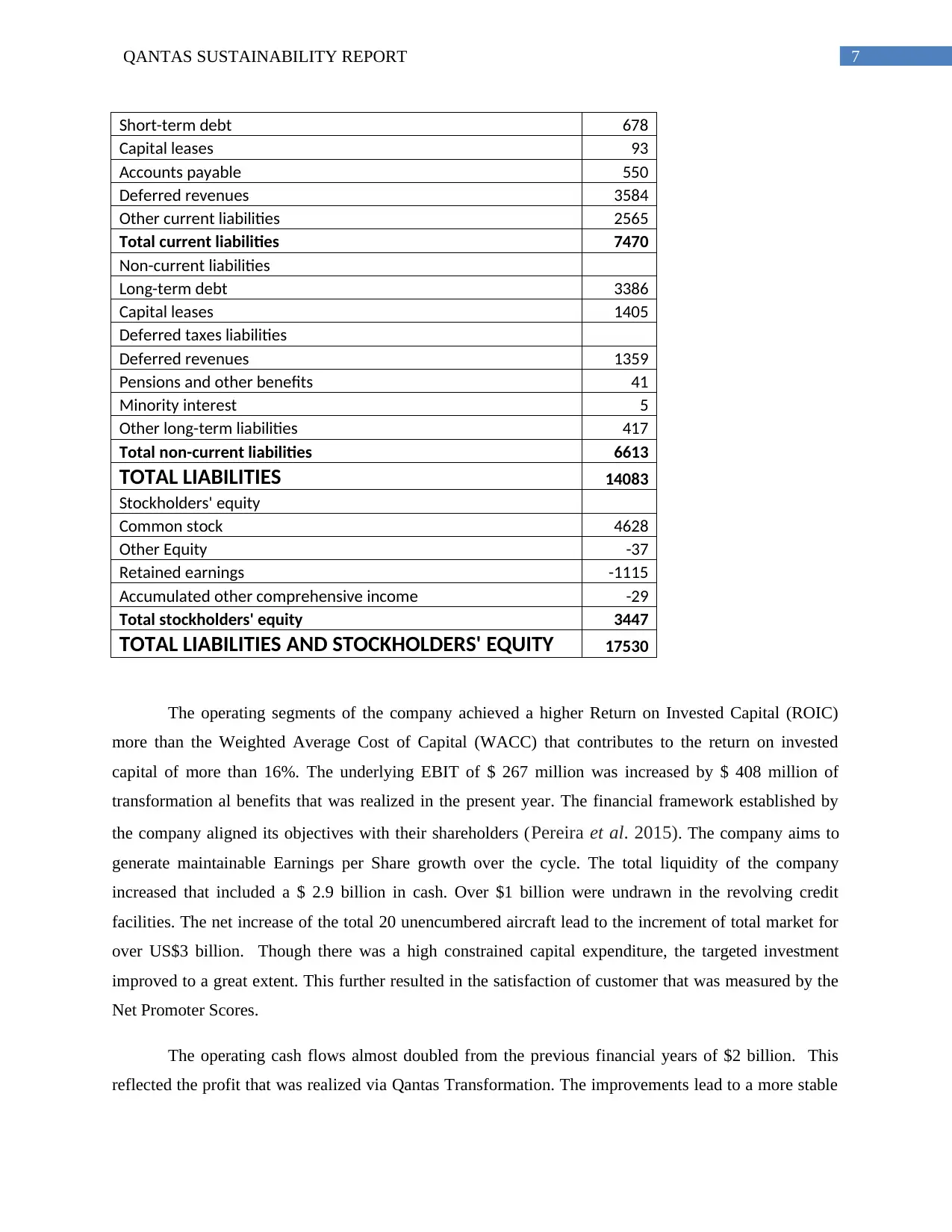
7QANTAS SUSTAINABILITY REPORT
Short-term debt 678
Capital leases 93
Accounts payable 550
Deferred revenues 3584
Other current liabilities 2565
Total current liabilities 7470
Non-current liabilities
Long-term debt 3386
Capital leases 1405
Deferred taxes liabilities
Deferred revenues 1359
Pensions and other benefits 41
Minority interest 5
Other long-term liabilities 417
Total non-current liabilities 6613
TOTAL LIABILITIES 14083
Stockholders' equity
Common stock 4628
Other Equity -37
Retained earnings -1115
Accumulated other comprehensive income -29
Total stockholders' equity 3447
TOTAL LIABILITIES AND STOCKHOLDERS' EQUITY 17530
The operating segments of the company achieved a higher Return on Invested Capital (ROIC)
more than the Weighted Average Cost of Capital (WACC) that contributes to the return on invested
capital of more than 16%. The underlying EBIT of $ 267 million was increased by $ 408 million of
transformation al benefits that was realized in the present year. The financial framework established by
the company aligned its objectives with their shareholders (Pereira et al. 2015). The company aims to
generate maintainable Earnings per Share growth over the cycle. The total liquidity of the company
increased that included a $ 2.9 billion in cash. Over $1 billion were undrawn in the revolving credit
facilities. The net increase of the total 20 unencumbered aircraft lead to the increment of total market for
over US$3 billion. Though there was a high constrained capital expenditure, the targeted investment
improved to a great extent. This further resulted in the satisfaction of customer that was measured by the
Net Promoter Scores.
The operating cash flows almost doubled from the previous financial years of $2 billion. This
reflected the profit that was realized via Qantas Transformation. The improvements lead to a more stable
Short-term debt 678
Capital leases 93
Accounts payable 550
Deferred revenues 3584
Other current liabilities 2565
Total current liabilities 7470
Non-current liabilities
Long-term debt 3386
Capital leases 1405
Deferred taxes liabilities
Deferred revenues 1359
Pensions and other benefits 41
Minority interest 5
Other long-term liabilities 417
Total non-current liabilities 6613
TOTAL LIABILITIES 14083
Stockholders' equity
Common stock 4628
Other Equity -37
Retained earnings -1115
Accumulated other comprehensive income -29
Total stockholders' equity 3447
TOTAL LIABILITIES AND STOCKHOLDERS' EQUITY 17530
The operating segments of the company achieved a higher Return on Invested Capital (ROIC)
more than the Weighted Average Cost of Capital (WACC) that contributes to the return on invested
capital of more than 16%. The underlying EBIT of $ 267 million was increased by $ 408 million of
transformation al benefits that was realized in the present year. The financial framework established by
the company aligned its objectives with their shareholders (Pereira et al. 2015). The company aims to
generate maintainable Earnings per Share growth over the cycle. The total liquidity of the company
increased that included a $ 2.9 billion in cash. Over $1 billion were undrawn in the revolving credit
facilities. The net increase of the total 20 unencumbered aircraft lead to the increment of total market for
over US$3 billion. Though there was a high constrained capital expenditure, the targeted investment
improved to a great extent. This further resulted in the satisfaction of customer that was measured by the
Net Promoter Scores.
The operating cash flows almost doubled from the previous financial years of $2 billion. This
reflected the profit that was realized via Qantas Transformation. The improvements lead to a more stable
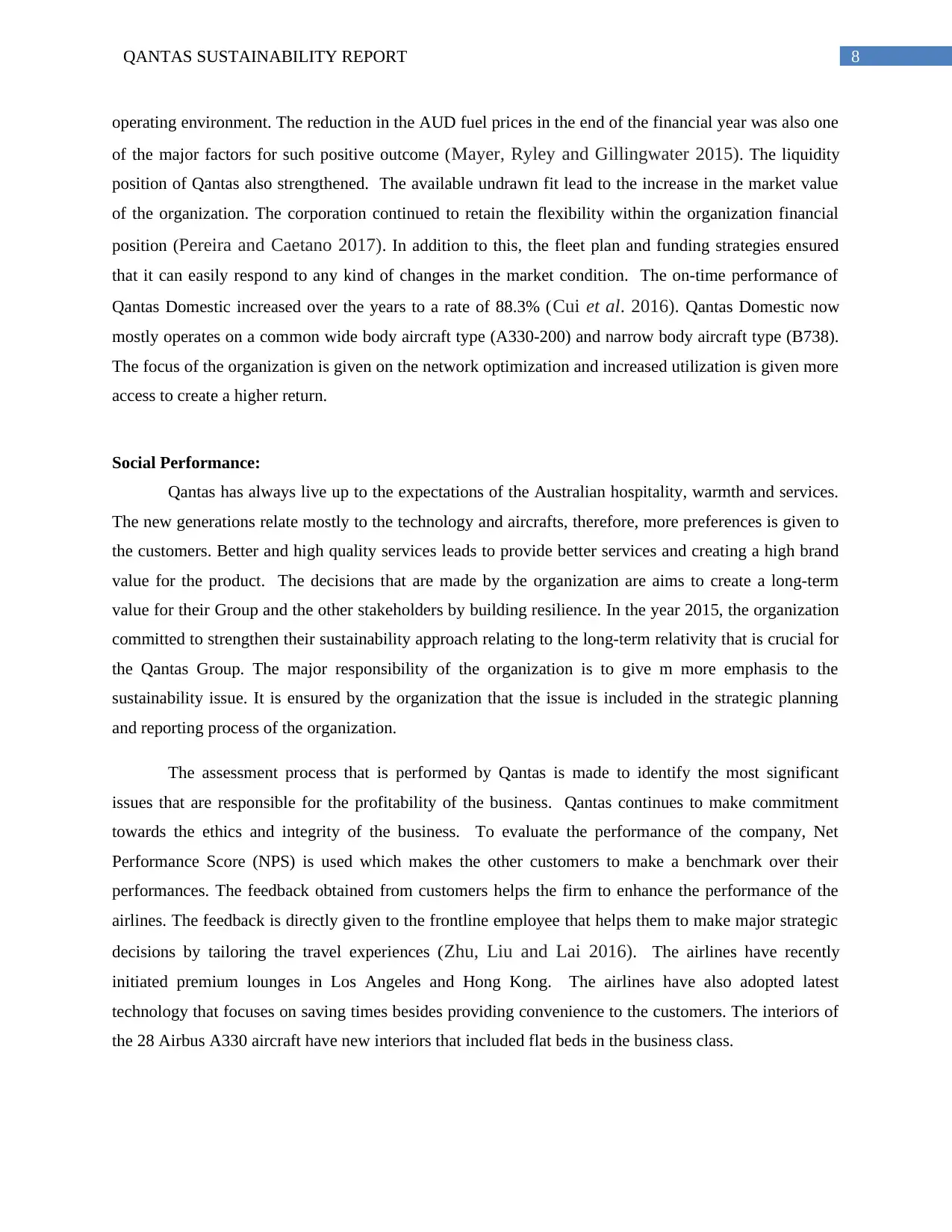
8QANTAS SUSTAINABILITY REPORT
operating environment. The reduction in the AUD fuel prices in the end of the financial year was also one
of the major factors for such positive outcome (Mayer, Ryley and Gillingwater 2015). The liquidity
position of Qantas also strengthened. The available undrawn fit lead to the increase in the market value
of the organization. The corporation continued to retain the flexibility within the organization financial
position (Pereira and Caetano 2017). In addition to this, the fleet plan and funding strategies ensured
that it can easily respond to any kind of changes in the market condition. The on-time performance of
Qantas Domestic increased over the years to a rate of 88.3% (Cui et al. 2016). Qantas Domestic now
mostly operates on a common wide body aircraft type (A330-200) and narrow body aircraft type (B738).
The focus of the organization is given on the network optimization and increased utilization is given more
access to create a higher return.
Social Performance:
Qantas has always live up to the expectations of the Australian hospitality, warmth and services.
The new generations relate mostly to the technology and aircrafts, therefore, more preferences is given to
the customers. Better and high quality services leads to provide better services and creating a high brand
value for the product. The decisions that are made by the organization are aims to create a long-term
value for their Group and the other stakeholders by building resilience. In the year 2015, the organization
committed to strengthen their sustainability approach relating to the long-term relativity that is crucial for
the Qantas Group. The major responsibility of the organization is to give m more emphasis to the
sustainability issue. It is ensured by the organization that the issue is included in the strategic planning
and reporting process of the organization.
The assessment process that is performed by Qantas is made to identify the most significant
issues that are responsible for the profitability of the business. Qantas continues to make commitment
towards the ethics and integrity of the business. To evaluate the performance of the company, Net
Performance Score (NPS) is used which makes the other customers to make a benchmark over their
performances. The feedback obtained from customers helps the firm to enhance the performance of the
airlines. The feedback is directly given to the frontline employee that helps them to make major strategic
decisions by tailoring the travel experiences (Zhu, Liu and Lai 2016). The airlines have recently
initiated premium lounges in Los Angeles and Hong Kong. The airlines have also adopted latest
technology that focuses on saving times besides providing convenience to the customers. The interiors of
the 28 Airbus A330 aircraft have new interiors that included flat beds in the business class.
operating environment. The reduction in the AUD fuel prices in the end of the financial year was also one
of the major factors for such positive outcome (Mayer, Ryley and Gillingwater 2015). The liquidity
position of Qantas also strengthened. The available undrawn fit lead to the increase in the market value
of the organization. The corporation continued to retain the flexibility within the organization financial
position (Pereira and Caetano 2017). In addition to this, the fleet plan and funding strategies ensured
that it can easily respond to any kind of changes in the market condition. The on-time performance of
Qantas Domestic increased over the years to a rate of 88.3% (Cui et al. 2016). Qantas Domestic now
mostly operates on a common wide body aircraft type (A330-200) and narrow body aircraft type (B738).
The focus of the organization is given on the network optimization and increased utilization is given more
access to create a higher return.
Social Performance:
Qantas has always live up to the expectations of the Australian hospitality, warmth and services.
The new generations relate mostly to the technology and aircrafts, therefore, more preferences is given to
the customers. Better and high quality services leads to provide better services and creating a high brand
value for the product. The decisions that are made by the organization are aims to create a long-term
value for their Group and the other stakeholders by building resilience. In the year 2015, the organization
committed to strengthen their sustainability approach relating to the long-term relativity that is crucial for
the Qantas Group. The major responsibility of the organization is to give m more emphasis to the
sustainability issue. It is ensured by the organization that the issue is included in the strategic planning
and reporting process of the organization.
The assessment process that is performed by Qantas is made to identify the most significant
issues that are responsible for the profitability of the business. Qantas continues to make commitment
towards the ethics and integrity of the business. To evaluate the performance of the company, Net
Performance Score (NPS) is used which makes the other customers to make a benchmark over their
performances. The feedback obtained from customers helps the firm to enhance the performance of the
airlines. The feedback is directly given to the frontline employee that helps them to make major strategic
decisions by tailoring the travel experiences (Zhu, Liu and Lai 2016). The airlines have recently
initiated premium lounges in Los Angeles and Hong Kong. The airlines have also adopted latest
technology that focuses on saving times besides providing convenience to the customers. The interiors of
the 28 Airbus A330 aircraft have new interiors that included flat beds in the business class.
⊘ This is a preview!⊘
Do you want full access?
Subscribe today to unlock all pages.

Trusted by 1+ million students worldwide
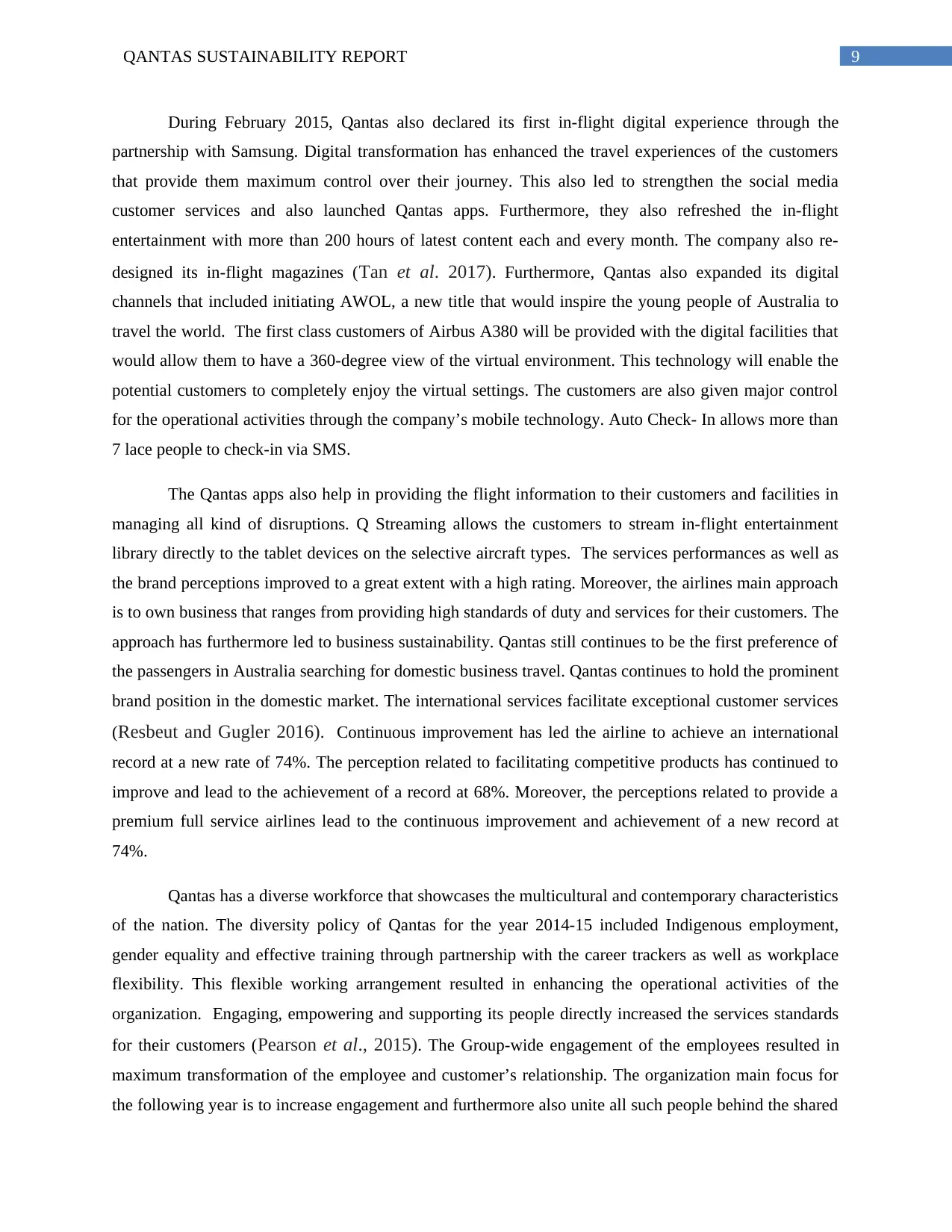
9QANTAS SUSTAINABILITY REPORT
During February 2015, Qantas also declared its first in-flight digital experience through the
partnership with Samsung. Digital transformation has enhanced the travel experiences of the customers
that provide them maximum control over their journey. This also led to strengthen the social media
customer services and also launched Qantas apps. Furthermore, they also refreshed the in-flight
entertainment with more than 200 hours of latest content each and every month. The company also re-
designed its in-flight magazines (Tan et al. 2017). Furthermore, Qantas also expanded its digital
channels that included initiating AWOL, a new title that would inspire the young people of Australia to
travel the world. The first class customers of Airbus A380 will be provided with the digital facilities that
would allow them to have a 360-degree view of the virtual environment. This technology will enable the
potential customers to completely enjoy the virtual settings. The customers are also given major control
for the operational activities through the company’s mobile technology. Auto Check- In allows more than
7 lace people to check-in via SMS.
The Qantas apps also help in providing the flight information to their customers and facilities in
managing all kind of disruptions. Q Streaming allows the customers to stream in-flight entertainment
library directly to the tablet devices on the selective aircraft types. The services performances as well as
the brand perceptions improved to a great extent with a high rating. Moreover, the airlines main approach
is to own business that ranges from providing high standards of duty and services for their customers. The
approach has furthermore led to business sustainability. Qantas still continues to be the first preference of
the passengers in Australia searching for domestic business travel. Qantas continues to hold the prominent
brand position in the domestic market. The international services facilitate exceptional customer services
(Resbeut and Gugler 2016). Continuous improvement has led the airline to achieve an international
record at a new rate of 74%. The perception related to facilitating competitive products has continued to
improve and lead to the achievement of a record at 68%. Moreover, the perceptions related to provide a
premium full service airlines lead to the continuous improvement and achievement of a new record at
74%.
Qantas has a diverse workforce that showcases the multicultural and contemporary characteristics
of the nation. The diversity policy of Qantas for the year 2014-15 included Indigenous employment,
gender equality and effective training through partnership with the career trackers as well as workplace
flexibility. This flexible working arrangement resulted in enhancing the operational activities of the
organization. Engaging, empowering and supporting its people directly increased the services standards
for their customers (Pearson et al., 2015). The Group-wide engagement of the employees resulted in
maximum transformation of the employee and customer’s relationship. The organization main focus for
the following year is to increase engagement and furthermore also unite all such people behind the shared
During February 2015, Qantas also declared its first in-flight digital experience through the
partnership with Samsung. Digital transformation has enhanced the travel experiences of the customers
that provide them maximum control over their journey. This also led to strengthen the social media
customer services and also launched Qantas apps. Furthermore, they also refreshed the in-flight
entertainment with more than 200 hours of latest content each and every month. The company also re-
designed its in-flight magazines (Tan et al. 2017). Furthermore, Qantas also expanded its digital
channels that included initiating AWOL, a new title that would inspire the young people of Australia to
travel the world. The first class customers of Airbus A380 will be provided with the digital facilities that
would allow them to have a 360-degree view of the virtual environment. This technology will enable the
potential customers to completely enjoy the virtual settings. The customers are also given major control
for the operational activities through the company’s mobile technology. Auto Check- In allows more than
7 lace people to check-in via SMS.
The Qantas apps also help in providing the flight information to their customers and facilities in
managing all kind of disruptions. Q Streaming allows the customers to stream in-flight entertainment
library directly to the tablet devices on the selective aircraft types. The services performances as well as
the brand perceptions improved to a great extent with a high rating. Moreover, the airlines main approach
is to own business that ranges from providing high standards of duty and services for their customers. The
approach has furthermore led to business sustainability. Qantas still continues to be the first preference of
the passengers in Australia searching for domestic business travel. Qantas continues to hold the prominent
brand position in the domestic market. The international services facilitate exceptional customer services
(Resbeut and Gugler 2016). Continuous improvement has led the airline to achieve an international
record at a new rate of 74%. The perception related to facilitating competitive products has continued to
improve and lead to the achievement of a record at 68%. Moreover, the perceptions related to provide a
premium full service airlines lead to the continuous improvement and achievement of a new record at
74%.
Qantas has a diverse workforce that showcases the multicultural and contemporary characteristics
of the nation. The diversity policy of Qantas for the year 2014-15 included Indigenous employment,
gender equality and effective training through partnership with the career trackers as well as workplace
flexibility. This flexible working arrangement resulted in enhancing the operational activities of the
organization. Engaging, empowering and supporting its people directly increased the services standards
for their customers (Pearson et al., 2015). The Group-wide engagement of the employees resulted in
maximum transformation of the employee and customer’s relationship. The organization main focus for
the following year is to increase engagement and furthermore also unite all such people behind the shared
Paraphrase This Document
Need a fresh take? Get an instant paraphrase of this document with our AI Paraphraser
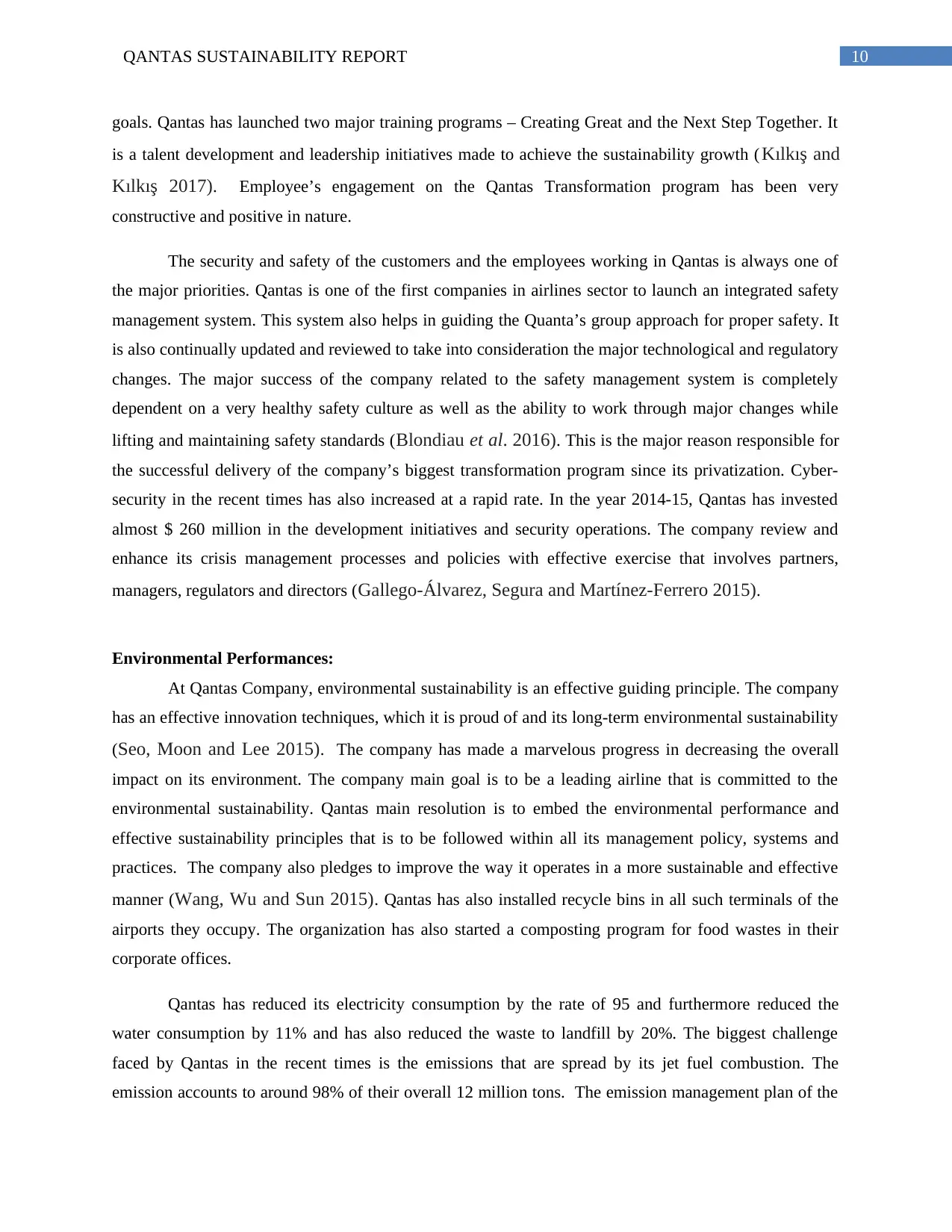
10QANTAS SUSTAINABILITY REPORT
goals. Qantas has launched two major training programs – Creating Great and the Next Step Together. It
is a talent development and leadership initiatives made to achieve the sustainability growth ( Kılkış and
Kılkış 2017). Employee’s engagement on the Qantas Transformation program has been very
constructive and positive in nature.
The security and safety of the customers and the employees working in Qantas is always one of
the major priorities. Qantas is one of the first companies in airlines sector to launch an integrated safety
management system. This system also helps in guiding the Quanta’s group approach for proper safety. It
is also continually updated and reviewed to take into consideration the major technological and regulatory
changes. The major success of the company related to the safety management system is completely
dependent on a very healthy safety culture as well as the ability to work through major changes while
lifting and maintaining safety standards (Blondiau et al. 2016). This is the major reason responsible for
the successful delivery of the company’s biggest transformation program since its privatization. Cyber-
security in the recent times has also increased at a rapid rate. In the year 2014-15, Qantas has invested
almost $ 260 million in the development initiatives and security operations. The company review and
enhance its crisis management processes and policies with effective exercise that involves partners,
managers, regulators and directors (Gallego-Álvarez, Segura and Martínez-Ferrero 2015).
Environmental Performances:
At Qantas Company, environmental sustainability is an effective guiding principle. The company
has an effective innovation techniques, which it is proud of and its long-term environmental sustainability
(Seo, Moon and Lee 2015). The company has made a marvelous progress in decreasing the overall
impact on its environment. The company main goal is to be a leading airline that is committed to the
environmental sustainability. Qantas main resolution is to embed the environmental performance and
effective sustainability principles that is to be followed within all its management policy, systems and
practices. The company also pledges to improve the way it operates in a more sustainable and effective
manner (Wang, Wu and Sun 2015). Qantas has also installed recycle bins in all such terminals of the
airports they occupy. The organization has also started a composting program for food wastes in their
corporate offices.
Qantas has reduced its electricity consumption by the rate of 95 and furthermore reduced the
water consumption by 11% and has also reduced the waste to landfill by 20%. The biggest challenge
faced by Qantas in the recent times is the emissions that are spread by its jet fuel combustion. The
emission accounts to around 98% of their overall 12 million tons. The emission management plan of the
goals. Qantas has launched two major training programs – Creating Great and the Next Step Together. It
is a talent development and leadership initiatives made to achieve the sustainability growth ( Kılkış and
Kılkış 2017). Employee’s engagement on the Qantas Transformation program has been very
constructive and positive in nature.
The security and safety of the customers and the employees working in Qantas is always one of
the major priorities. Qantas is one of the first companies in airlines sector to launch an integrated safety
management system. This system also helps in guiding the Quanta’s group approach for proper safety. It
is also continually updated and reviewed to take into consideration the major technological and regulatory
changes. The major success of the company related to the safety management system is completely
dependent on a very healthy safety culture as well as the ability to work through major changes while
lifting and maintaining safety standards (Blondiau et al. 2016). This is the major reason responsible for
the successful delivery of the company’s biggest transformation program since its privatization. Cyber-
security in the recent times has also increased at a rapid rate. In the year 2014-15, Qantas has invested
almost $ 260 million in the development initiatives and security operations. The company review and
enhance its crisis management processes and policies with effective exercise that involves partners,
managers, regulators and directors (Gallego-Álvarez, Segura and Martínez-Ferrero 2015).
Environmental Performances:
At Qantas Company, environmental sustainability is an effective guiding principle. The company
has an effective innovation techniques, which it is proud of and its long-term environmental sustainability
(Seo, Moon and Lee 2015). The company has made a marvelous progress in decreasing the overall
impact on its environment. The company main goal is to be a leading airline that is committed to the
environmental sustainability. Qantas main resolution is to embed the environmental performance and
effective sustainability principles that is to be followed within all its management policy, systems and
practices. The company also pledges to improve the way it operates in a more sustainable and effective
manner (Wang, Wu and Sun 2015). Qantas has also installed recycle bins in all such terminals of the
airports they occupy. The organization has also started a composting program for food wastes in their
corporate offices.
Qantas has reduced its electricity consumption by the rate of 95 and furthermore reduced the
water consumption by 11% and has also reduced the waste to landfill by 20%. The biggest challenge
faced by Qantas in the recent times is the emissions that are spread by its jet fuel combustion. The
emission accounts to around 98% of their overall 12 million tons. The emission management plan of the
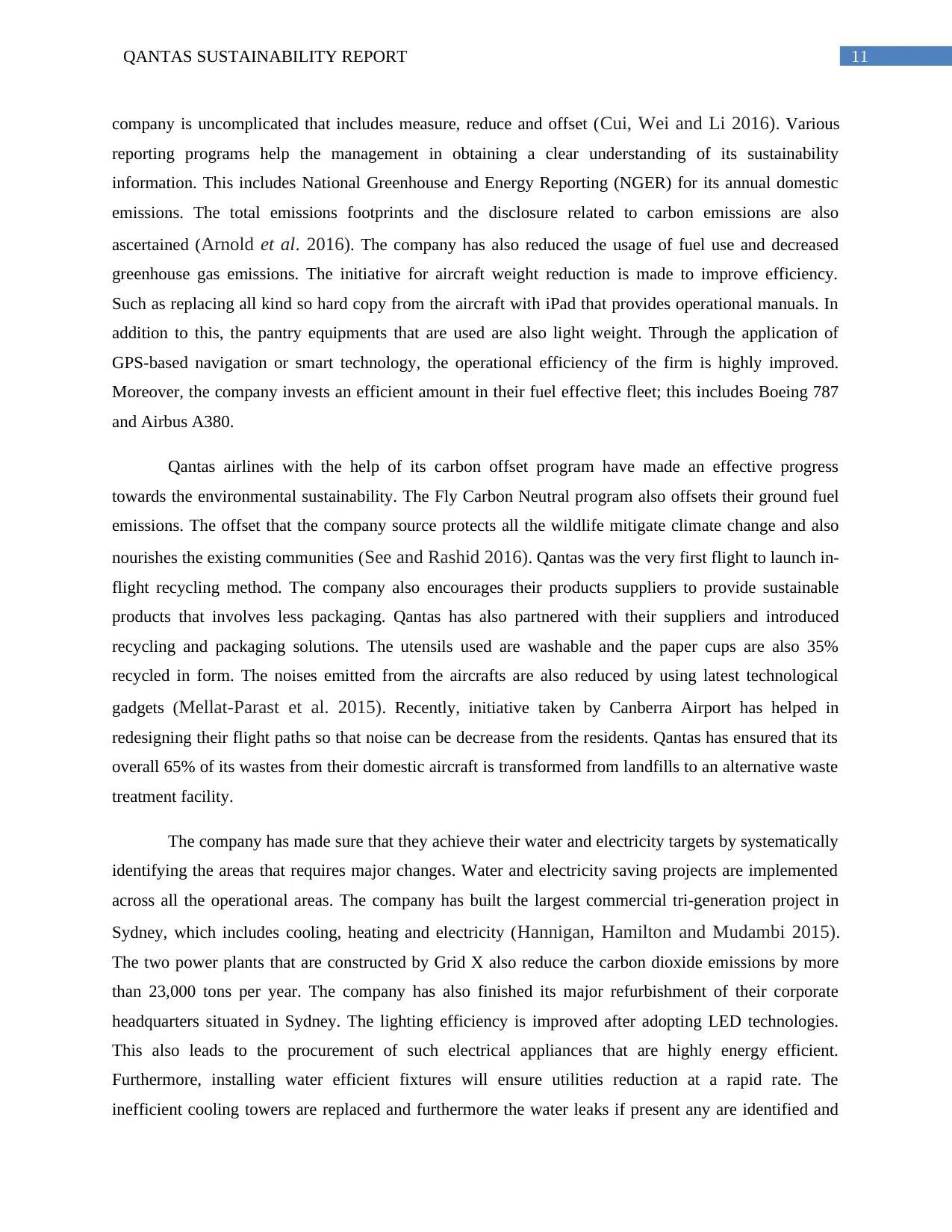
11QANTAS SUSTAINABILITY REPORT
company is uncomplicated that includes measure, reduce and offset (Cui, Wei and Li 2016). Various
reporting programs help the management in obtaining a clear understanding of its sustainability
information. This includes National Greenhouse and Energy Reporting (NGER) for its annual domestic
emissions. The total emissions footprints and the disclosure related to carbon emissions are also
ascertained (Arnold et al. 2016). The company has also reduced the usage of fuel use and decreased
greenhouse gas emissions. The initiative for aircraft weight reduction is made to improve efficiency.
Such as replacing all kind so hard copy from the aircraft with iPad that provides operational manuals. In
addition to this, the pantry equipments that are used are also light weight. Through the application of
GPS-based navigation or smart technology, the operational efficiency of the firm is highly improved.
Moreover, the company invests an efficient amount in their fuel effective fleet; this includes Boeing 787
and Airbus A380.
Qantas airlines with the help of its carbon offset program have made an effective progress
towards the environmental sustainability. The Fly Carbon Neutral program also offsets their ground fuel
emissions. The offset that the company source protects all the wildlife mitigate climate change and also
nourishes the existing communities (See and Rashid 2016). Qantas was the very first flight to launch in-
flight recycling method. The company also encourages their products suppliers to provide sustainable
products that involves less packaging. Qantas has also partnered with their suppliers and introduced
recycling and packaging solutions. The utensils used are washable and the paper cups are also 35%
recycled in form. The noises emitted from the aircrafts are also reduced by using latest technological
gadgets (Mellat-Parast et al. 2015). Recently, initiative taken by Canberra Airport has helped in
redesigning their flight paths so that noise can be decrease from the residents. Qantas has ensured that its
overall 65% of its wastes from their domestic aircraft is transformed from landfills to an alternative waste
treatment facility.
The company has made sure that they achieve their water and electricity targets by systematically
identifying the areas that requires major changes. Water and electricity saving projects are implemented
across all the operational areas. The company has built the largest commercial tri-generation project in
Sydney, which includes cooling, heating and electricity (Hannigan, Hamilton and Mudambi 2015).
The two power plants that are constructed by Grid X also reduce the carbon dioxide emissions by more
than 23,000 tons per year. The company has also finished its major refurbishment of their corporate
headquarters situated in Sydney. The lighting efficiency is improved after adopting LED technologies.
This also leads to the procurement of such electrical appliances that are highly energy efficient.
Furthermore, installing water efficient fixtures will ensure utilities reduction at a rapid rate. The
inefficient cooling towers are replaced and furthermore the water leaks if present any are identified and
company is uncomplicated that includes measure, reduce and offset (Cui, Wei and Li 2016). Various
reporting programs help the management in obtaining a clear understanding of its sustainability
information. This includes National Greenhouse and Energy Reporting (NGER) for its annual domestic
emissions. The total emissions footprints and the disclosure related to carbon emissions are also
ascertained (Arnold et al. 2016). The company has also reduced the usage of fuel use and decreased
greenhouse gas emissions. The initiative for aircraft weight reduction is made to improve efficiency.
Such as replacing all kind so hard copy from the aircraft with iPad that provides operational manuals. In
addition to this, the pantry equipments that are used are also light weight. Through the application of
GPS-based navigation or smart technology, the operational efficiency of the firm is highly improved.
Moreover, the company invests an efficient amount in their fuel effective fleet; this includes Boeing 787
and Airbus A380.
Qantas airlines with the help of its carbon offset program have made an effective progress
towards the environmental sustainability. The Fly Carbon Neutral program also offsets their ground fuel
emissions. The offset that the company source protects all the wildlife mitigate climate change and also
nourishes the existing communities (See and Rashid 2016). Qantas was the very first flight to launch in-
flight recycling method. The company also encourages their products suppliers to provide sustainable
products that involves less packaging. Qantas has also partnered with their suppliers and introduced
recycling and packaging solutions. The utensils used are washable and the paper cups are also 35%
recycled in form. The noises emitted from the aircrafts are also reduced by using latest technological
gadgets (Mellat-Parast et al. 2015). Recently, initiative taken by Canberra Airport has helped in
redesigning their flight paths so that noise can be decrease from the residents. Qantas has ensured that its
overall 65% of its wastes from their domestic aircraft is transformed from landfills to an alternative waste
treatment facility.
The company has made sure that they achieve their water and electricity targets by systematically
identifying the areas that requires major changes. Water and electricity saving projects are implemented
across all the operational areas. The company has built the largest commercial tri-generation project in
Sydney, which includes cooling, heating and electricity (Hannigan, Hamilton and Mudambi 2015).
The two power plants that are constructed by Grid X also reduce the carbon dioxide emissions by more
than 23,000 tons per year. The company has also finished its major refurbishment of their corporate
headquarters situated in Sydney. The lighting efficiency is improved after adopting LED technologies.
This also leads to the procurement of such electrical appliances that are highly energy efficient.
Furthermore, installing water efficient fixtures will ensure utilities reduction at a rapid rate. The
inefficient cooling towers are replaced and furthermore the water leaks if present any are identified and
⊘ This is a preview!⊘
Do you want full access?
Subscribe today to unlock all pages.

Trusted by 1+ million students worldwide
1 out of 18
Related Documents
Your All-in-One AI-Powered Toolkit for Academic Success.
+13062052269
info@desklib.com
Available 24*7 on WhatsApp / Email
![[object Object]](/_next/static/media/star-bottom.7253800d.svg)
Unlock your academic potential
Copyright © 2020–2025 A2Z Services. All Rights Reserved. Developed and managed by ZUCOL.



